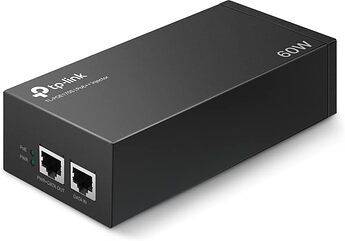Power-over-Ethernet (PoE) devices can provide and receive power through an Ethernet cable. PoE devices could be:
- PoE Switch (connects and powers multiple PoE cameras)
- PoE Injector (connects and powers one PoE camera)
There are however different kinds of power levels when talking about PoE. Some devices require more power like the ADC-VC729P PoE Floodlight Camera so make sure you check which one you may need. These are:
- PoE 44-57V DC @ 15.4W (802.3af)
- PoE+ 50-57V DC @ 30W (802.3at)
- PoE++ 50-57V DC @ 60W (802.3bt)
Video devices capable of using Power-over-Ethernet only require one cable for both power and data. PoE cameras from Alarm.com cameras include:
- ADC-VC727P (PoE 12.5W)
- ADC-VDB755P (PoE 15.4W)
- ADC-VC729P (PoE++)
The maximum distance that PoE can provide power is 100 meters (328 feet).
PoE Switch
A PoE switch would be used when powering multiple PoE cameras. When looking for a PoE switch, you will have to make sure that there is enough power provided by the switch to power all of your devices.
An example PoE switch is the TP-Link TL-SF1005P (4 PoE ports @ 67W total power).
The TL-SF1005P supports PoE and PoE+. It is not a PoE++ switch and therefore will not work with the ADC-VC729P PoE Floodlight Camera.
PoE Injector
A PoE injector works similarly to a switch but only provides Power-over-Ethernet to one video camera device. A PoE injector is also the most common type of device to power a PoE++ device like the ADC-VC729P.
An example PoE++ injector is the TP-Link TL-PoE170S which works great with the ADC-VC729P PoE Floodlight Camera.

